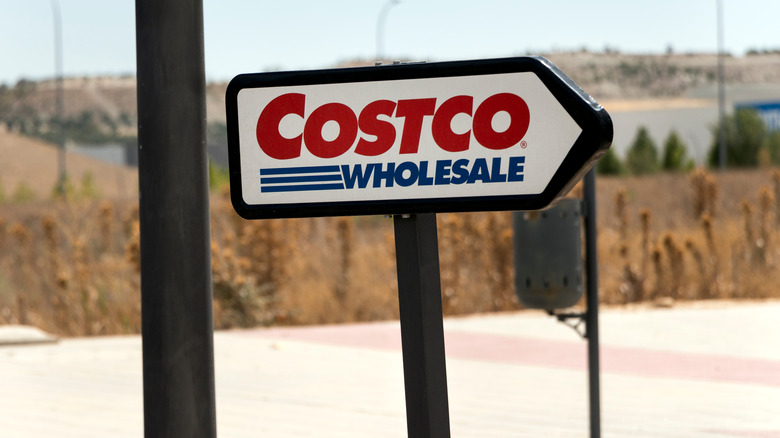Costco Has A Secret Weapon In Its Inflation Battle With Walmart
Walmart is the largest retailer in the U.S., according to Statista, which puts its annual sales at $430.82 billion. Costco, by contrast, is the fifth largest, with sales of around $121.22 billion. Yet Wall Street analysts tend to lump these two together based on the perception that when investors start losing confidence in Walmart, as reflected by downward trends in its share price, they also tend to pull back from Costco ownership, according to TheStreet, which attributes to the downward trend in Costco share price over the last six months. In fact, investors are generally concerned over the performance of retail companies as inflation rises to record-breaking highs (via Consumer Price Index).
In the wake of its recent first-quarter earnings report, Walmart stock plummeted more than it did on October 19, 1987 — aka Black Monday, per Financial Times. Moreover, Financial Times blames this historic drop on Walmart having revised its full-year profit forecast downward in light of the realities of inflation and its damaging effects on consumer spending habits as well as retailer profit margins. In response, as explained by The Motley Fool, Costco share prices decreased by 13%.
That being said, Costco stock is performing better than the market, which decreased nearly 17% during the same timeframe. In fact, Wall Street is bullish on Costco stock at the moment, in part, because Costco has a collection of secret weapons in its arsenal.
Costco delivers higher customer satisfaction
A full 90% of Americans live "within 10 miles" of a Walmart (via TheStreet). That's an advantage over Costco, which has a mere 574 U.S. locations, per ScrapeHero. Nevertheless, it would appear that, if given the choice, American shoppers would choose to shop at Costco, even if it might require putting gas in the car at exorbitant prices.
According to a recent American Customer Satisfaction Index survey — based on interviews with 36,517 customers chosen at random throughout the 2021 calendar year — Walmart is ranked dead last among all retailers (via TheStreet). By comparison, Costco ranks as the favorite overall, with top scores in numerous categories and a total index of 81, as compared with Walmart's total index of 70. And just to give you a sense of how much Americans resent shopping at Walmart, TheStreet notes that a score of 70 puts Walmart on par with cable and internet providers, which, we probably don't have to tell you are widely reviled.
To put it in even more concrete terms, despite numerous lockdowns and Costco suspending its free sample program, the grocery chain saw a "10% bump" in new memberships, according to Costco senior vice president of finance and investor relations Bob Nelson (via The Motley Fool). Even more importantly, Costco reported a record-breaking 92% retention rate among its existing members. So, how does Costco deliver this level of customer satisfaction?
Costco's footprint may be small-ish, but that works in its favor
Costco has 828 locations, with 574 in the U.S., as of May 2022, according to ScrapeHero. Walmart has more than 10,000, with somewhere in the vicinity of 4,000 stateside, per Statista. This translates to Costco having 288,000 employees in total and Walmart having 2.2 million (via Investopedia). But more is not always better, as Costco is proving. As Investopedia explains, Costco's small-ish size enables it to pay its store employees as much as $25 per hour, plus a cafeteria plan of benefits.
In fact, if you were to start working at a Costco today, you wouldn't make less than $17 an hour. Moreover, promotions are made from within, which means that employee retention is high, and further, by the time a Costco employee is promoted to a management position, they already have considerable experience with Costco, its processes, and its values.
By contrast, Walmart, which pays $11 to new retail hires and no more than $15.15 for full-time work — and has a history of decreasing hours to match increases in wages — is in no position to compete with Costco's level of customer service. And as Investopedia further points out, Walmart's size means it is in no position to offer a more attractive package to its workers. Further, despite its apparent economies of scale, Walmart's vast footprint means that acquiring its inventory involves extensive shipping costs, with upward pressure on its retail prices as the upshot.
Ultimately, Costco's membership model is everything
With or without inflation, Walmart constantly battles to keep its prices low to attract customers who'd otherwise pass on its shopping experience, which may leave something to be desired, per TheStreet. Sometimes Walmart wins in that regard, but overall, it's an enormous challenge due to its large-footprint-related high inventory acquisition costs, not to mention the enormous sums it finds itself compelled to spend in order to attract a constant flow of new and returning customers (via Investopedia).
Costco, by contrast, has a smaller footprint, is more competitive in attracting customer-facing employees, doesn't have to spend much on advertising, and doesn't even have to sell its inventory to keep raking in the revenues. The secret behind all of this? Costco's membership-driven business model, which limits its footprint and the related costs, while developing a built-in customer base, without the need for coming up with a steady flow of clever promotions to draw people into its stores. As discussed above, Costco continues to attract new members while retaining more than 92% of its existing members, per The Motley Fool.
Having paid the membership fee, members tend to return to spend their money at Costco. Having received scads of membership fees — to the tune of nearly $1 billion in its most recent fiscal quarter — Costco can afford to offer low, if not consistently best, prices because it has money in hand without having even made a sale.



